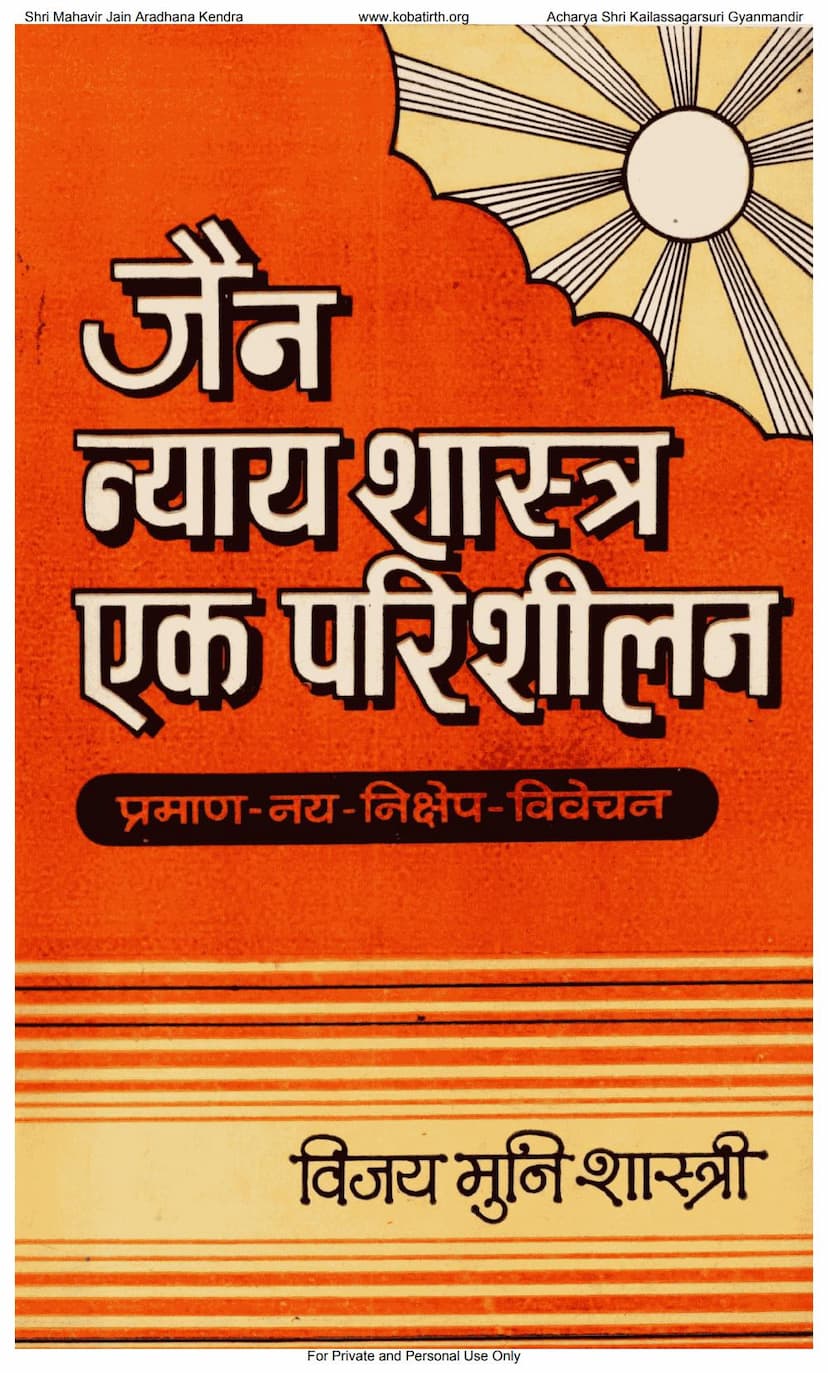Jain Nyayashastra Ek Parishilan
Added to library: September 2, 2025

Summary
Here's a comprehensive summary of the Jain text "Jain Nyayashastra Ek Parishilan" by Vijaymuni, based on the provided pages:
Book Title: Jain Nyayashastra Ek Parishilan (A Study of Jain Logic) Author: Vijaymuni Shastri Publisher: Diwakar Prakashan, Agra Core Subject: Pramana (Means of Valid Knowledge), Naya (Standpoints), and Nikshepa (Classification/Placement) within Jain Logic.
Overview and Author's Intent:
The book "Jain Nyayashastra Ek Parishilan" by Vijaymuni Shastri is a concise and accessible exploration of the fundamental principles of Jain logic (Nyaya Shastra). The author's primary aim is to demystify complex Jain philosophical concepts for a wider audience, particularly for those in the Jain community who may not have extensive knowledge of Sanskrit or Prakrit, the traditional languages of Jain scriptures.
The author, Vijaymuni Shastri, expresses a deep concern about the declining study of philosophy and logic, especially in Hindi and other vernacular languages. He notes that while Indian philosophy has a rich tradition, accessing primary texts on logic, which are often in Sanskrit or Prakrit, is challenging due to language barriers and the time and effort required for mastery. Inspired by well-wishers and particularly by Shri Shrichandji Surana 'Saras', the author decided to present the core elements of Jain logic in a simple and lucid manner.
The book aims to cover all aspects of Jain logic and its methodology, even resorting to repetition where necessary for clarity. The author acknowledges the diverse approaches of various Acharyas and credits Shri Shrichandji Surana for his significant contribution to the book's presentation, including its design, printing, and illustrations.
Key Concepts Explored:
The central themes of the book revolve around understanding Jain philosophy through its logical framework. The book elaborates on:
-
Pramana (Means of Valid Knowledge): The text emphasizes the necessity of understanding Pramana for comprehending Jain scriptures and philosophy. It outlines the Jain perspective on how valid knowledge is acquired, distinguishing between direct (Pratyaksha) and indirect (Paroksha) means of knowledge. The book discusses the five types of knowledge in Jainism (Mati, Shruta, Avadhi, Manahparyaya, and Kevala) and how they relate to Pramana. It details the classification of Pramanas, particularly the Jain acceptance of two primary types: Pratyaksha and Paroksha, and how other philosophical schools' accepted Pramanas are subsumed within these two. The discussion on Pratyaksha includes its direct soul-originated forms (Avadhi, Manahparyaya, Kevala) and indirect/instrumental forms (Mati, Shruta).
-
Naya (Standpoints/Viewpoints): Naya is presented as a crucial tool for understanding the multifaceted nature of reality as espoused by Jainism. The book explains that Naya represents different perspectives or standpoints from which an object can be viewed. It highlights the seven main Nayas in Jainism: Naigama, Samgraha, Vyavahara, Rujusutra, Shabda, Samabhirudha, and Evambhuta. The text discusses the relationship between Nayas and the broader concepts of Anekaanta (non-one-sidedness) and Syadvada (conditional predication). It also touches upon the distinction between Naya and its fallacious forms (Nayabhasa).
-
Nikshepa (Classification/Placement): Nikshepa is explained as a method of classifying words and concepts according to their intended meaning or context. This system is vital for resolving ambiguities and understanding the precise import of terms used in Jain literature. The book details the four types of Nikshepa: Nama (Name), Sthapana (Establishment/Representation), Dravya (Substance/Potential), and Bhava (State/Actualization). It illustrates how these classifications help in interpreting the intended meaning of words, especially in the context of Jain practices and philosophy.
-
Anekaanta and Syadvada: The book underscores that Anekaanta (multiplicity of viewpoints) and Syadvada (conditional predication) are the cornerstones of Jain philosophy. Understanding Pramana, Naya, and Nikshepa is presented as essential for grasping these foundational principles. The text emphasizes that these concepts allow for a comprehensive and non-contradictory understanding of reality, acknowledging that objects possess infinite attributes, and different standpoints reveal different aspects.
-
Comparative Philosophy: The book offers a comparative overview of Indian philosophical systems, including Charvaka, Buddhism, Samkhya-Yoga, Nyaya-Vaisheshika, Mimamsa, and Vedanta, along with a brief mention of Western logic. This comparative approach helps contextualize Jain logic within the broader intellectual landscape of India and the West. It highlights both the unique contributions of Jain philosophy and its points of convergence or divergence with other schools.
Structure and Content:
The book is structured to guide the reader from an introduction to Indian logic and philosophy to the specifics of Jain logic. Key sections include:
- Introduction to Indian Logic: Discussing the origin and importance of logic (Nyaya Vidya) in Indian thought, its relation to philosophy, and its role in establishing and defending doctrines.
- Overview of Indian Philosophies: Briefly introducing the main schools of Indian thought, their core tenets, and their views on Pramana.
- Jain Philosophy and Logic: Delving into the Jain framework, its emphasis on Pramana, Naya, and Nikshepa, and how these concepts underpin Anekaanta and Syadvada.
- Detailed Explanation of Pramana, Naya, and Nikshepa: These sections form the core of the book, meticulously explaining the definitions, classifications, and significance of each concept within Jainism.
- Appreciation of Key Jain Logicians: The book mentions prominent Jain Acharyas like Manikyanandi, Vadideva Suri, Hemachandra Suri, Akalanka Deva, and Yashovijayaji, and their contributions to Jain logic.
- Sutratmak Granthas (Aphoristic Texts): The book also briefly mentions important Jain logical texts and their authors, such as Parikshamukha, Pramana-Naya-Tattvalokalamkara, and Pramana-Mimamsa.
- Appendix: Including references to key sutras from foundational texts and comparative insights into Western logic.
Significance of the Book:
"Jain Nyayashastra Ek Parishilan" serves as a valuable resource for anyone seeking to understand the logical underpinnings of Jain philosophy. By making complex subjects like Pramana, Naya, and Nikshepa accessible, Vijaymuni Shastri contributes to the preservation and dissemination of Jain intellectual heritage. The book bridges the gap between classical Jain texts and contemporary readers, making the profound wisdom of Jain logic available to a broader audience.